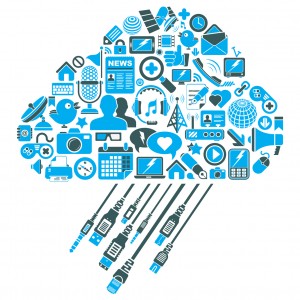Why Do We Need Optical Fiber to Get to the "Cloud" ?
In the past several decades, technologies have evolved almost immeasurably, certainly including the development of data storage. Humankind has always tried to find ways to store information. People have become accustomed to technological terminology, such as CD-ROM, USB Key, and DVD. But today, the most advanced storage solution may be the cloud computing. About how to achieve the "cloud", some people say that optical fiber is the key to cloud computing. So, what is cloud computing and why do we need optical fiber to get there? Today, we are going to the "Cloud" and find the out answer.
What Is Cloud Computing and Why Is It Called as "Cloud"?
Though the term "cloud computing" is everywhere and closely linked with our life, we do not really know what it is just like many terminologies that we don't know. However, unlike other terminologies, we are more interested in cloud computing because of its attractive features, applications or maybe the interesting name. Why is it called as "cloud" but not "rain" or "snow"? The most simple explanation is that we usually use "cloud" to represent the network. "Cloud" the term describes an image of the complex infrastructure, which cover all the technical details. Obviously, the cloud computing has nothing to do with the weather "cloud". It is just an analogy to give it a body to imagine. In fact, cloud computing is a model for computing transforming. In this model, data and computation are operated somewhere in a "cloud", which is some collection of data centers owned and maintained by a third party. This enables ubiquitous, convenient, on-demand network access to a shared pool of configurable computing resources that can be rapidly provisioned and released with minimal management effort or service provider interaction.
There are public cloud, private cloud and hybrid cloud. When a cloud is made available in a pay-as-you-go manner to the general public, we call it a public cloud. And when the cloud infrastructure is operated solely for a business or an organization, it is called private cloud. A composition of public and private cloud is called hybrid cloud. A hybrid cloud integrates the advantages of public cloud and private cloud, where private cloud is able to maintain high service availability by scaling up their system with externally provisioned resources from a public cloud when there are rapid workload fluctuations or hardware failures.
Generally, cloud computing may be considered to include the following layers of service: IaaS (Infrastructure as a Service), PaaS (Platform as a Service) and SaaS (Software as a Service).
- IaaS (Infrastructure as a Service) - Offering web-based access to storage and computing power. Consumer can get service from a full computer infrastructure through the Internet. IaaS Examples: Amazon Web Services (AWS), Microsoft Azure, Google Compute Engine (GCE), Joyent.
- PaaS (Platform as a Service) - Giving developers the tools to build and host web applications. PaaS Examples: Apprend, Microsoft Azure.
- SaaS (Software as a Service) - Applications that are accessible from various client devices through a thin client interface such as a web browser. SaaS Examples: Google Apps, Salesforce, Workday, Concur, Citrix GoToMeeting, Cisco WebEx.
Optical Fiber Is the Key to the "Cloud"
The implementation of cloud computing depends on high bandwidth. If without an enough bandwidth, cloud computing is impossible. In the "cloud", users' terminals are simplified into a pure and single device with only input and output functions but meanwhile utilize the powerful computing and processing functions from the "cloud". This means that the terminal must have a very fast connection, because the simple terminal means fast network and powerful platform requirement, where "pipes" are put forward higher requirement. Thus, fiber is the ideal "pipe" for cloud computing.
In fact, increasingly more computer applications, software and even file storage now reside on the Internet or in the "cloud". Yet another driving force is mobile Internet traffic, which relies heavily on cloud computing. It is said that there is over 1 Exabyte (i.e. 1,073,741,824 Gigabytes) of data currently stored in the that will limit your ability to work seemlessly in the "cloud" is your Internet connection. Thus, to access the tremendous amounts data we need fiber networks that can carry Terabits - one trillion bits per second. Optical fiber can offer more available bandwidth and speed which meets the demands of the "cloud". Obviously, no technology is more effective at meeting that challenge than fiber at present.
FTTH and Cloud Computing
When talking about optical fiber, FTTH (Fiber to the Home) may be the hot topic. FTTH infrastructure is expected as a solution to the growing demands for high bandwidth. It brings fiber-optic connections directly into homes, allowing for delivery speeds up to a possible 100 Mbps, or even more. These speeds open the door to a variety of new services and applications for residential, business and public service markets. The relationship between FTTH and cloud computing is subtle. FTTH which will encourage growth in cloud computing with its benefits. And the growth of cloud computing may drive the development of FTTH.
The Future
Cloud computing is seen by many as the next generation of information technology. The abundant supply of information technology capabilities offers many benefits to our lives. However, like any new technology advancement, cloud computing also faces many challenges, e.g. cloud security. Though there are many unknown factors in the "cloud" waiting for us to explore, it is no doubt that we need optical fibers in order to better reach the "cloud". Now, with the benefits of optical fibers, the cloud computing is increasingly developing. Will it automatically work out better and cheaper for you in the long term? What's your opinion?
for more information.




没有评论:
发表评论